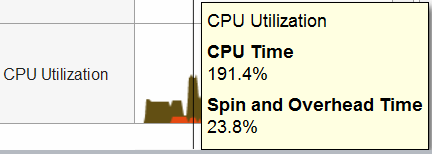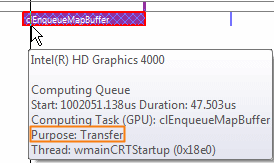Visible to Intel only — GUID: GUID-B32C5B89-C6D1-48E6-9846-857ADFBFC24C
Visible to Intel only — GUID: GUID-B32C5B89-C6D1-48E6-9846-857ADFBFC24C
Pane: Timeline
Use the Timeline pane to see metrics over time, at the thread or platform level. Use this information to identify patterns and anomalies in the data.
In the Timeline pane, you can hover, zoom-in, and filter the data at interesting points in time to get more detail. Typically the Timeline pane is located at the bottom of the window. For the views which focus on the distribution of metrics distribution over time, the Timeline pane can occupy the upper or central part of the window. The analysis type and viewpoint manage the data presented in the Timeline pane.
The Timeline pane typically provides the following data:

|
Toolbar- Navigation control to zoom in/out the view on areas of interest. For more details on the Timeline controls, go to Managing Timeline View. |
|
Platform metrics- Depending on the analysis type, the Timeline pane can present several areas with platform specific metrics like GPU engine usage, computing queue for OpenCL™ applications, bandwidth data, or power consumption. The most detailed analysis of the platform metrics is available with the Timeline pane in the Platform window. |
|
Application metrics per grouping level-Depending on the viewpoint, the data may be represented by threads, modules, processes, cores, packages, and other units monitored by the data collector during the analysis run. For most of the viewpoints, the Thread grouping is the default. For some viewpoints, you can change the grouping level using the drop-down menu in the Legend area. Grouping of hierarchical information in the Timeline pane displays in groups of the top five most critical results. You can expand the grouping to load additional results. Note that the CPU Time metric value provided in the Thread area is applicable to a particular thread where 100% is the maximum possible utilization for a thread. For example, for the selection above 94.2% of CPU Time utilization means that the thread was active 94.2% of time and 5.8% it was waiting. |
|
Selected metrics-Data on the most representative metrics displays in separate rows. This data demonstrates the overall application performance over time (for example, CPU Usage or GPU HW metrics) or system-wide execution (for example, GPU Usage). See Reference for Performance Metrics for detailed metrics description. Note that the CPU Utilization metric in the Timeline pane is calculated as a sum of CPU time per each thread where 100% is the maximum possible utilization per CPU. For example, at the moment selected in the picture below the application utilized 1.91 of logical CPU cores (if every CPU is 100%, then 191% is 1.91) out of 4, and 0.23 of CPU was used by the application threads for overhead or spinning. This means that the application utilized only 1.68 of CPUs effectively.
|
|
Legend-Types of data presented on the timeline. Filter in/out any type of data presented in the timeline by selecting/deselecting corresponding check boxes. The list of performance metrics presented in the view depend on the selected analysis type and viewpoint. VTune Profiler also uses special indicators to classify the presented data on the timeline:
|
|
Tooltips-Hover over a chart element to get statistics on this metric/program unit for the selected moment of time. |
For the GPU analysis of applications using OpenCL software technology, the Timeline pane in the Graphics window provides the following tabs:
Platform tab that focuses on a per-thread and per-process distribution of the CPU and GPU hardware metrics collected during the analysis run.
Architecture Diagram tab that is provided for OpenCL application analysis collected with the Analyze Processor Graphics hardware events option on systems with Intel® HD Graphics and Intel® Iris® Graphics. This tabs helps better understand the distribution of the GPU hardware metrics per architecture blocks for the period the selected OpenCL kernel was running.
Collecting energy analysis data with Intel® SoC Watch is available for target Android*, Windows*, or Linux* devices. Import and viewing of the Intel SoC Watch results is supported with any version of Intel® VTune™ Profiler.






 Markers. Color markers indicate an area on the timeline when a particular task/ frame/event/etc. was executed. Hover over a marker to see the execution details for the selected element. The following markers are available:
Markers. Color markers indicate an area on the timeline when a particular task/ frame/event/etc. was executed. Hover over a marker to see the execution details for the selected element. The following markers are available: 


